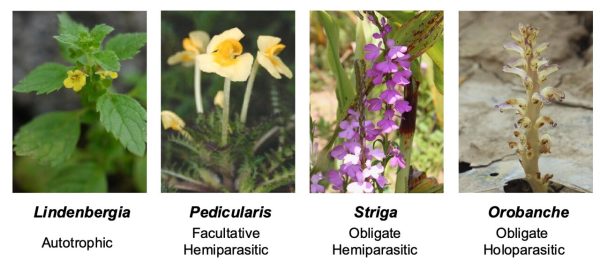Parasitic plants evolved from autotrophs. Initially, certain autotrophs evolved to be facultative hemiparasitic plants which obtained only water and mineral nutrients from their hosts as supplements. Some of the facultative hemiparasitic plants later became obligate parasitic plants that had to depend on their hosts to complete their life cycles. Then gradually holoparasitic plants evolved from obligate parasites and they completely lost their photosynthesis capacity. In angiosperms, parasitic plants independently evolved 12 or 13 times. In eight parasitic plant lineages, hemiparasitic species became extinct, leaving only holoparasites remaining. However, the Orobanchaceae (Lamiales), the largest family of parasitic plants, comprises autotrophic and parasitic plants with all degrees of parasitism. This makes it by far the best family for studying the origin and evolution of plant parasitism.
Recently, Xu et al. assembled three high-quality genomes of orobanchaceous plants, the autotrophic plant Lindenbergia luchunensis and the holoparasitic plants Phelipanche aegyptiaca and Orobanche cumana. Phylogenomic analysis of these three genomes together with those previously published and the transcriptomes of other orobanchaceous species, created a robust phylogenetic framework for Orobanchaceae. It was found that an ancient whole-genome duplication (WGD; about 73.48 Mya), which predated the origin of Orobanchaceae, might have contributed to the emergence of parasitism. However, no WGD events occurred in any lineages of the orobanchaceous parasites except for Striga after divergence from their autotrophic common ancestor, suggesting that in contrast to previous speculations, WGD is not associated with the emergence of holoparasitism. Xu et al. detected evident convergent gene loss in all parasites within Orobanchaceae and between Orobanchaceae and dodder Cuscuta australis. The gene families in the orobanchaceous parasites showed a clear pattern of recent gains and expansions. The expanded gene families are enriched in functions related to the development of the haustorium, suggesting that recent gene family expansions may have facilitated the adaptation of orobanchaceous parasites to different hosts. This study illustrates a stepwise pattern in the evolution of parasitism in the orobanchaceous parasites, and will facilitate future studies on parasitism and the control of parasitic plants in agriculture.
For the full paper see here
